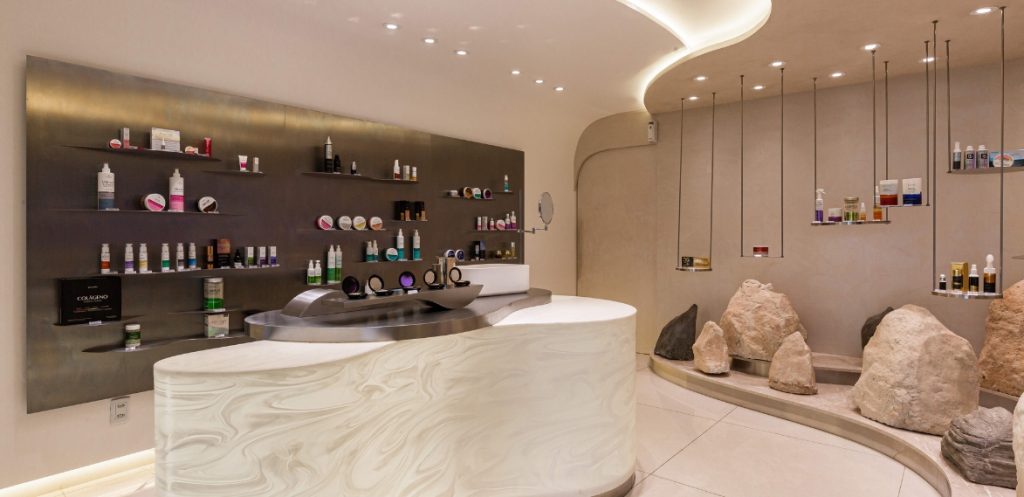The 7 Retail Design trends for 2023 were presented at Futuro:co, our front page on trends in the future, and now we've made the content available for you to read.
People's post-pandemic behavior has changed, which has also altered their shopping routines and relationship with environments.
Knowing about these changes is essential for brands that want to remain protagonists in their markets.
A Gabriela Pavan, Managing Partner of Retail and Experience, curated and presented these trends along with success stories from her personal studies and practical applications.
A necessary read for anyone who has contact with physical environments and wants to grow.
- Cultural crossover
- Multi-sensory environments
- Atmospheric nature
- Technological innovations that become transformative
- Unusual occurrences in society and/or the environment
- Serene futurism
- Renaissance
1. Cultural crossover
Globalization has made everything very accessible.
This has made it possible to introduce cultural elements into new environments, such as the reformulation of classic products from one country to another.

Duas is the project of a Spanish woman and a Brazilian woman. Together, they have created a space that is more than just a store, it is a meeting and conversation point.
2. Multi-sensory environments
It's to see, to hear, to touch, to feel...
With the return of socialization, we are even more impacted by our senses. Aesthetics, which have always been present in our daily lives, are no longer enough. We need sensory intelligence in every contact.

Séren invited us to design the brand on its stand, designing an enchanting journey for its customers. We developed a sensory journey, from the creation of a drink to a fragrance to heighten the sales atmosphere.
3. Atmospheric nature
Bringing out the best in the natural environment.
Technology and nature come together in immersive, biophilic environments.

Grupo Natureza is a multi-franchise group that needed to encourage its employees to return to the office, thinking of an environment that represented their personality. The solution we came up with was a project that strikes a balance between warmth and modernity.
4. Technological innovations that become transformative
What if the things we know today don't exist in 10 years' time?
These are products or processes that have the capacity to make major changes.

CASA SEAT is a hub for mobility, culture, design and innovation. Created for a new SEAT brand experience, the space has an agenda of cultural and mobility events, with the aim of creating closer relationships with customers and potential customers.
5. Unusual occurrences in society and/or the environment
How and why do we do what we do?
Long-term changes are emerging with the power to transform the way we work, play, love and exist.

Can you imagine having a place where you can bathe your pet yourself, without having to clean up afterwards? Fresh Animals is a self-service center for pets where you can wash, dry and deodorize your pet and also wash your clothes.
6. Serene futurism
The future can be in the present.
Serene futurism consists of spaces updated with natural materials and references. Making the intersection between natural and artificial.

Tulipia is an advanced cosmetology company that invited us in 2020 to transform its store environment. The project aimed to solve the visualization and distribution of products, the visual and sensory experience and solve the purchase and checkout journey. See the full case here.
7. Renaissance
What if one of the futures is to recreate the past?
Rebirth is the reintroduction of the past manifesting itself in a new environment in an attempt to be sustainable.

Cuz is an extremely sustainable clothing atelier. The space has a showroom, workshop with visible sewing machines, showroom and studio. The brand's philosophy is "our clothes dress our bodies, but also our values, priorities and lifestyles".

Gabriela Pavan
He specializes in Retail Design and Visual Merchandising at IED-SP and IED Barcelona, with an MBA in Interior Design and Space Production (IPOG).
An architect and urban planner from UDC - PR, with an extension in Architecture and Engineering from the Università Deli Studi Roma TRE (Italy), she has worked for commercial architecture firms and construction companies.
During his career, he has developed commercial and corporate projects for various brands such as Lar Cooperativa Agroindustrial, Sicredi and Grupo Siagri. He is VP of the central-west POPAI Brazil meeting. He has led award-winning projects for POPAI Brasil, the Brasil Design Awards and Bornancini.
